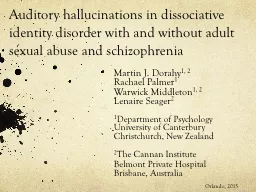

without adult sexual abuse and schizophrenia Martin J Dorahy 1 2 Rachael Palmer 1 Warwick Middleton 1 2 Lenaire Seager 2 1 Department of Psychology University of Canterbury Christchurch New Zealand ID: 302128
Download Presentation The PPT/PDF document "Auditory hallucinations in dissociative ..." is the property of its rightful owner. Permission is granted to download and print the materials on this web site for personal, non-commercial use only, and to display it on your personal computer provided you do not modify the materials and that you retain all copyright notices contained in the materials. By downloading content from our website, you accept the terms of this agreement.
Slide1
Auditory hallucinations in dissociative identity disorder with and without adult sexual abuse and schizophrenia
Martin J. Dorahy1, 2Rachael Palmer1Warwick Middleton1, 2Lenaire Seager21Department of PsychologyUniversity of CanterburyChristchurch, New Zealand2The Cannan InstituteBelmont Private Hospital Brisbane, Australia
Orlando, 2015Slide2
Voices & dissociative disordersVoice hearing in dissociative disorders has a long history (e.g., Hart, 1926;
Kluft, 1987; ; Middleton & Butler, 1998; Prince, 1905; Ross, 2004; Ross et al., 1995).Recent empirical work has dispelled some previously held beliefs; e.g.,Slide3
Voices internal for DID and external for schizophrenia
Eg., Honig et al. (1998): no difference in location of voices in schizophrenia and dissociative disorders Both experienced voices inside and outside the head. Even more nuanced than thatSch
N
=33
DID
N=29
Sig (
)Location: Inside Outside Both59%24%18%52%3%45%NS**
Dorahy et al., 2009Slide4
AH as psychological and dissociative
Dissociation strongly linked to AH (e.g., Anketell et al., 2010; Brewin & Patel, 2010; Dorahy et al., 2009; Kilcommons et al., 2008; Schäfer et al., 2008).Growing movement towards viewing AH as psychological and dissociative, rather than biogenetic and psychotic (Longden et al., 2011; Moskowtiz & Corsten, 2007). Laddis
& Dell (2012) caution that the dissociative experiences in schizophrenia, may in fact be dissociative-like, and not reflect dissociative experiences in
traumatised
and dissociative individuals
“We
believe that the
underlying mechanisms of the seemingly dissociative phenomena in schizophrenia are different from the underlying mechanisms of the dissociative phenomena in DID.”Slide5
Dorahy et al. 2009N = 6529 DID
18 schizophrenia with child maltreatment16 schizophrenia without child maltreatment.Later two groups had persistent AHSchizophrenia voice experience looks somewhat different from DID. DID more likely to:Start before 18Hear constantlyHear both internally and externallyHear more than 2 voicesHear both child and adult voicesSlide6
Laddis & Dell, 2012DID (40), schiz in remission (20),
schiz active (20)DID higher incidence of: child voicesvoices that converse or argue Angry & persecutory voicesDID lower incidence of:delusionsSlide7
Current study Further explored voice hearing in DID and schizophrenia, and delusionsTwo DID groups:Abuse ended before 18
Sexual abuse after 18 (often/v.often) (growing interest in ongoing abuse, Middleton, 2013)To pick up potential differences in DID groupingsSlide8
Sample
Age: F(2,54) = .88, p = .42DID Abuse in childhoodDID sexual abuse adulthoodSchizophreniaN252111age44.8045.0440.09SexM=1F=24M=0F=21M=11F=0Slide9
MeasuresDES; DES-TInterpretation of Voices Inventory (IVI; 26 items
Meta-physical beliefs about voices (e.g., They mean that I am close to God).Positive beliefs (e.g., They help me keep control).Loss of control (e.g., They control the way I think).Formal Thought Disorder – SAPS (8 items e.g., derailment, illogicality)Peter’s et al. Delusional Inventory (21 items); e.g., “Do you ever feel as if some people are not what they seem to be?” Psychotic Symptom Rating Scale (11 & 6 items)Auditory Hallucinations (e.g., frequency, location)Delusions (e.g, conviction)Slide10
Results: Child abuseAll participants reported a history of child abuse/neglect except 1 person with schizophrenia
DID Abuse in childhood (n=25)DID sexual abuse adulthood (n=21)Schizophrenia(n=11)Total CTQRange: 28-14091.00 (SD=17.98)94.71 (SD=16.32)45.45* (SD=12.15)Adult Phy&Sex ab.Range: 1-41.5* (SD=.59)3.39 (SD=1)1.18 *(SD=.31)Slide11
Pathological Dissociation
Schizophrenia sig lower than 2 DID samplesSlide12
Frequency of AH
DID Abuse in childhood (n=25)DID sexual abuse adulthood (n=21)Schizophrenia(n=11)Continuous voices44%57%27%All participants reported AH except one person with schizophreniaSlide13
Interpretation of Voices Inventory
*Slide14
Formal thought disorder - SAPS
Schizophrenia sig lower than 2 DID samplesSlide15
Peter’s et al. Delusional InventorySlide16
Initial summaryBoth DID groups (higher on Diss
) differed from schizo. on:More pathological dissociationMore continuous AHMore likely to hear solely insideMore formal thought disorderMore beliefs that voice mean they loss controlGenerally the DID groups showed the same symptoms frequency and were similar to the schizophrenia group on:Metaphysical beliefs about voicesDelusionBut do DDs differ when divided by dissociation and not adult abuse history?Slide17
Dissociation as putative mechanismsSample
Age: F(2,63) = .36, p = .69Low Path Diss DIDHigh Path Diss DIDSchizophreniaN252516age44.8445.4442.56SexM=1F=24M=1F=24M=14F=2Slide18
Child and adult abuse
Low DES-T DID (n=25)High DES-T DID (n=25)Schizophrenia(n=16)Total CTQRange: 28-14085* (SD=17.78)100*(SD=12.74)51*(SD=22.43)Adult Phy&Sex ab.Range: 1-42.06 (SD=1.1)2.71 (SD=1.2)1.16*(SD=.30)Slide19
Pathological Dissociation
All groups differ on pathol. dissociationSlide20
Interpretation of Voices Inventory
*Slide21
Formal thought disorder - SAPS
Schizophrenia sig lower than hi path diss. DID Slide22
Peter’s et al. Delusional InventorySlide23
DiscussionWith DID differentiated by dissociative symptom, High path diss DID higher than 2 other groups on:
Metaphyscial and loss of control explanations for voicesMore formal thought disorder than schizophreniaGroups did not differ on: positive beliefs about voicesGeneral Delusions (other studies show differences in delusion, Laddis & Dell, 2012)Slide24
Discussion - IIDID samples with child abuse only versus adult sexual abuse look
similar in thought disorder, hallucinatory and delusional symptom experience, Tend to be more severe than schizophrenia (except in delusions)However, when DID is differentiated on dissociative symptoms severity, the more severe group generally have more ‘psychotic’ symptoms, and the less severe group are similar to schizophrenia Severity of pathological dissociative symptoms in DID is a marker of more severe ‘psychotic’ symptom profile – all DID is not equal and pathological dissociation may create difference. Slide25
Implications‘Psychotic’ symptoms in DID should reduce in therapy as dissociation is dealt with.Assessing
the severe of pathological symptoms in DID is importantIs more severe ‘psychotic’ symptoms associated with dissociative structure or specific symptoms?